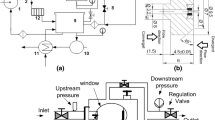Abstract
The purpose of this work is to describe the two-phase flow structure of cloud cavitation. The experimental study is performed in a cavitation tunnel equipped with a Venturi-type test section. The geometry studied is characterized by a convergent angle of 18° and a divergent angle of 8°. It leads to regular large vapour cloud shedding. The flow is investigated by means of an X-ray attenuation device. Twenty-four collimated detectors enable the instantaneous volume fraction of the vapour phase to be measured at different locations of the two-phase flow. The X-ray intensity measurement mode enables fast data acquisition (1,000 Hz). The results are compared with double optical probe measurements. The influences of the velocity and the size of the cavitation area on the time–space distribution of the vapour fraction are studied. The convection velocity of the vapour structures is estimated. The mean distribution of the volume fraction of the vapour phase during the shedding cycle is computed using the phase- averaging method.














Similar content being viewed by others
Abbreviations
- f :
-
frequency
- h :
-
width of the test section
- I :
-
X-ray intensity
- L cav :
-
mean size of the cavitation area
- M :
-
point of measurement
- p :
-
pressure
- S :
-
section
- St :
-
Strouhal number
- t :
-
time
- T :
-
acquisition time lag
- T Gi :
-
resident time of the ith gas particle at M
- U :
-
velocity
- V :
-
volume
- x :
-
distance from the throat of the test section
- X v :
-
vapour density function
- y :
-
distance from the Venturi bottom
- α(M):
-
local void fraction measured at M
- β :
-
volume fraction of the vapour phase
- μ :
-
mass absorption coefficient of the X-rays
- ρ :
-
density
- σ :
-
cavitation number
- τ :
-
delay
- —:
-
time-averaging operator
- <>:
-
space-averaging operator
- ref:
-
reference section
- v:
-
vapour
- w:
-
water
References
Callenaere M (1999) Etude des poches de cavitation partielle en écoulement interne. Doctoral Thesis, Institut National Polytechnique de Grenoble
Ceccio SL, Brennen CE (1991) Observations of the dynamics and acoustics of travelling bubble cavitation. J Fluid Mech 233:633–660
Coutier-Delgosha O, Fortes-Patella R, Reboud JL (2003) Evaluation of the turbulence model influence on the numerical simulations of unsteady cavitation. J Fluids Eng 125:38–45
Fruman D, Reboud JL, Stutz B (1999) Estimation of thermal effects in cavitation of thermosensible liquids. Int J Heat Mass Transfer 42:3195–3204
Judge CQ, Oweis GF, Ceccio SL, Jessup SD, Chesnakas CJ, Fry DJ (2001) Tip-leakage vortex inception on a ducted rotor. Paper presented at the Fourth International Symposium on Cavitation, California Institute of Technology, Pasadena, CA, 20–23 June
Kamono H, Kato H, Yamaguchi H, Miyanaga M (1993) Simulation of cavity flow by ventilated cavitation on a foil section. ASME Fed 163:183–189
Kunz RF, Boger DA, Stinebrin DR, Chyczewski TS, Lindau JW, Gibeling HJ, Venkateswaran S, Givindan TR (2000) A preconditioned Navier–Stokes method for two-phase flow with application to cavitation prediction. Comput Fluids 29:849
Le Q, Franc JP, Michel JM (1993) Partial cavities: global behaviour and mean pressure distribution. J Fluids Eng 115:243–248
Lush PA, Peters PI (1982) Visualisation of the cavitating flow in a Venturi type duct using high speed cine photography. Proceedings of the IAHR Conference on Operating Problems of Pump Stations and Power Plants, vol 1, no 5, pp 5–13Proc IAHR 1, No. 5
Merle L (1994) Etude experimentale et modèle physique d'un écoulement cavitant avec effet thermodynamique. Doctoral Thesis, Institut National Polytechnique de Grenoble
Reboud JL, Delannoy Y (1994) Two-phase flow modeling of unsteady cavitation. Paper presented at the 2nd International Symposium on Cavitation, Tokyo
Senocak I, Shyy W (2002) A pressure-based method for turbulent cavitating flow computations. J Comput Phys 1976:363–383
Stutz B, Reboud JL (1997) Experiment on unsteady cavitation. Exp Fluids 22:191–198
Stutz B, Reboud JL (2000) Measurements within unsteady cavitation. Exp Fluids 29:545–552
Acknowledgments
This work was carried out under contract from the French space agency (Centre National d'Etudes Spatiales): the authors wish to express their gratitude for this support.
Author information
Authors and Affiliations
Corresponding author
Rights and permissions
About this article
Cite this article
Stutz, B., Legoupil, S. X-ray measurements within unsteady cavitation. Exp Fluids 35, 130–138 (2003). https://doi.org/10.1007/s00348-003-0622-0
Received:
Accepted:
Published:
Issue Date:
DOI: https://doi.org/10.1007/s00348-003-0622-0




